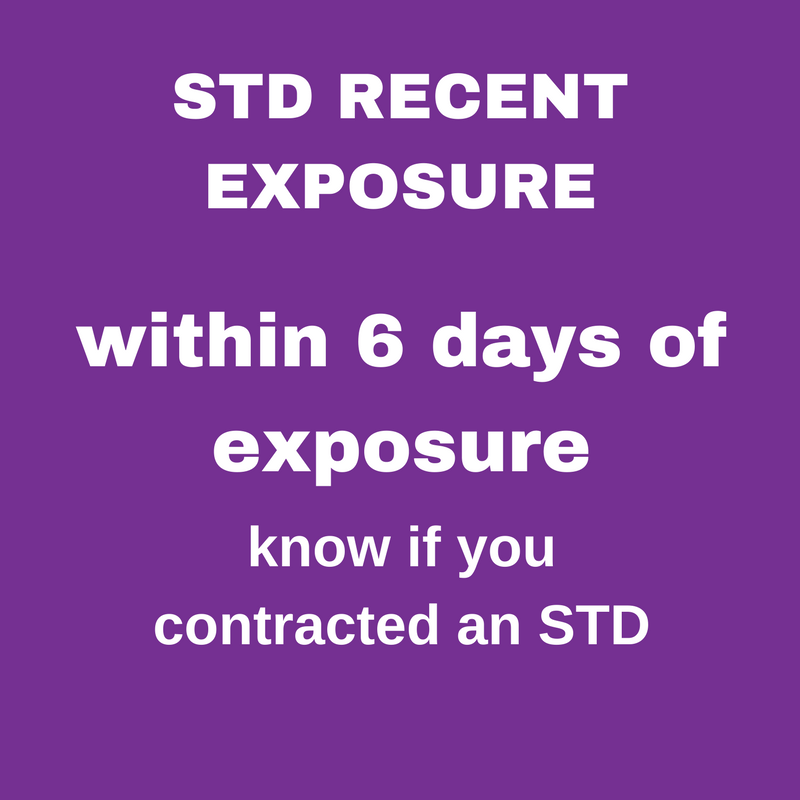STD RECENT EXPOSURE
Why Take This Test?
Recent exposure and you want to know now without waiting 6 or more weeks. We perform 9 tests to evaluate for recent exposure to sexually transmitted diseases. In the event some of these tests are positive the laboratory will automatically perform additional testing as required to assist your doctor with an accurate diagnosis and or confirmation so that you can make informed treatment decisions with your healthcare provider. These additional tests, if needed will be billed to the credit card used to purchase this panel. You will receive a courtesy call to let you know these charges are being processed.
Includes:
1. CHLAMYDIA/GC RNA, TMA,
Includes
Chlamydia trachomatis, Neisseria gonorrhoeae
Methodology
Dual Kinetic Assay (DKA) • Target Capture • Transcription-Mediated Amplification (TMA)
This test was performed using the APTIMA® COMBO2 Assay (GEN-PROBE).
Clinical Significance
C. trachomatis infections are the leading cause of sexually transmitted diseases in the United States. C. trachomatis is known to cause cervicitis, pelvic inflammatory disease (PID), epididymitis and proctitis. It is also the most frequent cause of non-gonococcal urethritis in men. Among women, the consequences of Chlamydialinfections are severe if left untreated.
Approximately half of Chlamydial infections are asymptomatic.
Neisseria gonorrhoeae (gonococci) is the causative agent of gonorrhea. In men, this disease generally results in anterior urethritis accompanied by purulent exudate. In women, the disease is most often found in the cervix, but the vagina and uterus may also be infected.
Methodology
Immunoassay (IA)
Reference Range(s)
Non-Reactive
Clinical Significance
HAV antibody indicates prior or acute infection with, or immunization to, Hepatitis A virus.
Alternative Name(s)
HAV Total,HAV Antibody
3. Hep B CORE AB TOTAL
Methodology
Immunoassay (IA)
Limitations
Patients receiving mouse antibody therapy may produce false-negative results. False-positives may be detected shortly after immunization to influenza and with patients with hypergammalobulinemia, positive rheumatoid factor, and connective tissue disorders.
Reference Range(s)
Non-Reactive
Clinical Significance
This assay does not distinguish between Total B core antibody IgG and IgM detected before or at the onset of symptoms; however, such reactivity can persist for years after illness, and may even outlast anti-HBs. Occasionally Hepatitis B core antibody may be the only marker of either current or past Hepatitis B infection.
4. Hep C AB
Includes
If Hepatitis C Antibody is reactive, then Hepatitis C Viral RNA, Quantitative, Real-Time PCR will be performed at an additional charge (CPT code(s): 87522).
Limitations
Results obtained from immunosuppressed patients should be interpreted with caution. Patients receiving mouse antibody therapy may produce false-negative results.
Clinical Significance
Hepatitis C Virus (HCV) is a major cause of hepatitis. The clinical symptoms of an HCV infection are variable. Infection with HCV results in a chronic infection in 50 to 80% of cases. The "window" between HCV acquisition and seroreactivity is highly variable; up to six months.
Alternative Name(s)
HCV with Reflex,HCV Antibody,Anti HCV
5. HSV 1/2 IGG HERPSELECT W REF
Includes
If Herpes Simplex Virus 2 (IgG) is >1.09, then HSV-2 Inhibition Study will be performed at an additional charge (CPT code(s): 86696).
Methodology
Immunoassay (IA)
Reference Range(s)
| Index | Interpretation |
| <0.90 | Negative |
| 0.90-1.09 | Equivocal |
| >1.09 | Positive |
Clinical Significance
Herpes Simplex Virus (HSV) is responsible for several clinically significant human viral diseases, with severity ranging from inapparent to fatal. Clinical manifestations include genital tract infections, neonatal herpes, meningoencephalitis, keratoconjunctivitis, and gingivostomatitis. There are two HSV serotypes that are closely related antigenically. HSV type 2 is more commonly associated with genital tract and neonatal infections, while HSV type 1 is more commonly associated with infections of non-genital sites. Specific typing is not usually required for diagnosis or treatment. The mean time to seroconversion using the type specific assay is 25 days. The performance of this assay has not been established for use in a pediatric population, for neonatal screening, or for testing of immunocompromised patients.
6. SYPHILIS
Includes
If RPR Screen is reactive, RPR titer will be performed at an additional charge (CPT code(s): 86593).
Limitations
False-positive results have been associated in patients with infections, pregnancy, autoimmune disease, old age, Gaucher disease, and malignancy.
Clinical Significance
This is a non-treponemal screening test for syphilis. False positive results may occur due to systemic lupus erythematosus, leprosy, brucellosis, atypical pneumonia, typhus, yaws, pinta, or pregnancy. Monitoring of RPR is helpful in assessing effectiveness of therapy.
Includes
If HIV Antigen and Antibody, 4th Generation Screen is Repeatedly Reactive, HIV-1/2 Antibody Differentiation will be performed at an additional charge (CPT code(s): 86701, 86702).
If HIV-1/2 Antibody Differentiation is Indeterminate or Negative, HIV-1 RNA, Qualitative, TMA will be performed at an additional charge (CPT code(s): 87535).
Reference Range(s)
| HIV Ag/Ab, 4th Generation | Non-Reactive |
Clinical Significance
This 4th generation HIV Ag/Ab Combo assay is intended to be used as an aid in the diagnosis of HIV1/HIV2 infection, including acute or primary HIV-1 infection.
Alternative Name(s)
Fourth Generation HIV,4th Generation HIV
8. HIV I RNA, QL, TMA
Methodology
Transcription-Mediated Amplification (TMA)
Reference Range(s)
| HIV-1 RNA, QN, TMA | Not detected |
This test was performed using the APTIMA® HIV-RNA Qualitative Assay (Gen-Probe).
Clinical Significance
The APTIMA® HIV-1 RNA, Qualitative assay may be used:
1. As an aid in the diagnosis of acute and primary HIV-1 infection.
2. To confirm HIV-1 infection in persons who repeatedly test positive for HIV-1 infection.
3. To resolve indeterminate or inconclusive HIV-1 Western blot results.
9. Urinalysis
Includes
Macroscopic and Microscopic Examinations
Methodology
Reagent Impregnated Strips/Tablets/Microscopic Examination
Clinical Significance
Dipstick urinalysis is important in accessing the chemical constituents in the urine and the relationship to various disease states. Microscopic examination helps to detect the presence of cells and other formed elements.
| CHLAMYDIA/GC RNA, TMA |
| Hep A AB, Total |
| Hep B CORE AB Total |
| Hep C AB |
| HSV 1/2 IGG HERPSELECT W REF |
| SYPHILIS |
| HIV 1/2 AG/AB, 4W/RFL |
| HIV I RNA, QL, TMA |
| Urinalisis |

